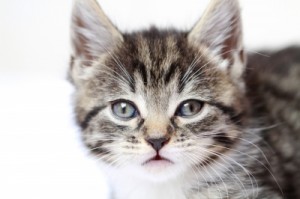It’s a common misconception that cats cannot be trained. It takes a lot of diligent hard work and patience, but it can be done. When it comes to training your cat, you’re probably looking for ways to get him to stop clawing at the furniture or climbing the drapes instead of getting him to sit or fetch.
Behavior modification is achievable and easier than you might imagine. As with everything in life, there is a not-so-great way to do it and then there’s the proper way.
Why Cats “Misbehave”
What may seem like unacceptable behavior to you, is in fact, natural and necessary behavior for your cat. For example: sharp claws are a vital survival tool. If the leg of your coffee table is the best means to sharpen her claws, your cat will utilize it.
Other undesirable behavior may be due to your cat having trouble dealing with change, feeling threatened or insecure, being unhappy with her litter box, not getting enough stimulation, or it may even be due to a health problem. Your cat is not “bad”, she is simply attempting to express to you that something is not right in her environment. She’s asking you for help the only way she knows how.
The Most Common Behavior Problems
 She’s not the only one that acts this way. Simple fixes may end her misbehavior. These common behavior problems often have a simple solution. A few of the most common problems include:
She’s not the only one that acts this way. Simple fixes may end her misbehavior. These common behavior problems often have a simple solution. A few of the most common problems include:
- Going outside the litter box. If she’s using the rest of the house as her litter box, try changing the type of litter, getting a new box that’s easier to access, moving the box to a quieter location away from loud noises or harsh smells, or simply keeping the litter cleaner and thoroughly sifted.
- Scratching furniture. If she’s using inappropriate objects as a scratching post, try offering new scratching posts made from different materials and praising her when she uses them. Some cats are fond of cardboard, while others enjoy the traditional carpeted scratching post. Still others prefer the texture of the twined posts. Entice her by rubbing some cat nip on the post and spraying deterrent (available at any pet specialty store) on unacceptable scratching areas she frequents.
- Playful biting and scratching. It’s important to begin guiding this behavior in kittens. They love to play and may get carried away by the fun of it all. Never use your hands as toys. Your cat should never think that a body part is prey or a toy. Kitten nibbles can be cute but it won’t be so cute when your adult cat bites and scratches you with adult teeth and claws.If your kitten begins to bite or scratch your hands during playtime, stop immediately and leave the room. This will send the message that that behavior is not okay. The same method will work with an adult cat that bites and scratches during play. Always try to use a toy, never your hands during play.If your cat goes for your hand or any part of your body, stop playing and leave the room. Not all bites are bad, some cats give love nibbles on the fingers while purring and being pet. These bites are generally soft and gentle. If this behavior is unacceptable, stop petting her and leave the room.
General Behavior Modification Methods That Cats Respond To
 If your cat is exhibiting other types of behavior that you’d like her to stop, there are some general training methods that work well for cats.
If your cat is exhibiting other types of behavior that you’d like her to stop, there are some general training methods that work well for cats.
- Positive reinforcement. Offer yummy treats, a loving pet, extra attention, or a few minutes of play time when your cat performs a desired action. Positive reinforcement works by associating a behavior with a positive outcome. This can only be done when the reward is given directly after the desired behavior is achieved. After a while, your cat will continue to perform the action even when she is not rewarded for it.
- Deterring bad behavior. You should always put more time and effort into rewarding your cat for good behavior than deterring her from undesirable behavior. The best way to deter your cat from performing certain actions is by high-pitched noises and/or water.Having a squirt gun handy and shooting a stream at your cat when she does something she’s not supposed to helps her know that what she did was wrong. It’s important to position yourself where she can’t see you squirting her. Otherwise she will associate your presence with the squirt and begin to avoid you. Making a loud “psssst” sound imitates hissing and conveys your disapproval of her actions. A loud clap with a firm “no” works as well.
- No physical punishment. Never hurt your cat by hitting, kicking or pinching. This is an attack, a threat. Your cat will be intimidated and learn to fear your presence or she may even retaliate during your “attack”.
When to Alert Your Veterinarian
 As mentioned above, some misbehavior may be attributed to an underlying medical problem. Some of which may include:
As mentioned above, some misbehavior may be attributed to an underlying medical problem. Some of which may include:
- Urinary tract infection (UTI) or other urinary problems
- Digestive disorders
- Internal parasites
- Anxiety
If you attempt to stop your cat’s misbehavior by every method available and nothing works, it may be time to see your vet. Also, if you notice other symptoms along with the misbehavior, such as:
- Vomiting
- Diarrhea
- Frequent urination
- Only producing small trickles of urine
- Uncharacteristic aggression
- Changes in appetite
As always, don’t hesitate to see your veterinarian.
Thanks for visiting www.catdandruffclinic.com, if you liked this article please like us using the side bar. And for more reading check out the Top Cat skin disorders every pet owner should know about.



Comments are closed.